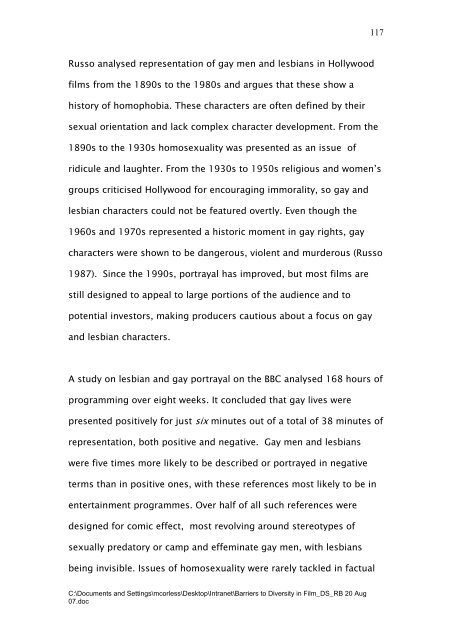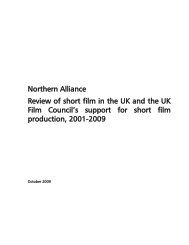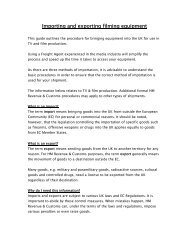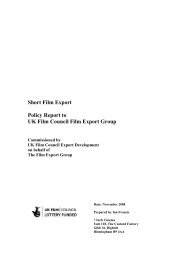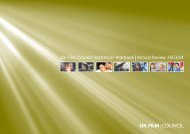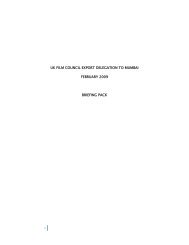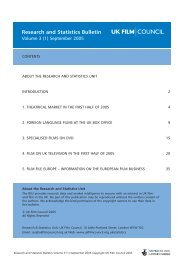Barriers to Diversity in Film – A Research Review – Aug 07
Barriers to Diversity in Film – A Research Review – Aug 07
Barriers to Diversity in Film – A Research Review – Aug 07
Create successful ePaper yourself
Turn your PDF publications into a flip-book with our unique Google optimized e-Paper software.
Russo analysed representation of gay men and lesbians <strong>in</strong> Hollywood<br />
films from the 1890s <strong>to</strong> the 1980s and argues that these show a<br />
his<strong>to</strong>ry of homophobia. These characters are often def<strong>in</strong>ed by their<br />
sexual orientation and lack complex character development. From the<br />
1890s <strong>to</strong> the 1930s homosexuality was presented as an issue of<br />
ridicule and laughter. From the 1930s <strong>to</strong> 1950s religious and women’s<br />
groups criticised Hollywood for encourag<strong>in</strong>g immorality, so gay and<br />
lesbian characters could not be featured overtly. Even though the<br />
1960s and 1970s represented a his<strong>to</strong>ric moment <strong>in</strong> gay rights, gay<br />
characters were shown <strong>to</strong> be dangerous, violent and murderous (Russo<br />
1987). S<strong>in</strong>ce the 1990s, portrayal has improved, but most films are<br />
still designed <strong>to</strong> appeal <strong>to</strong> large portions of the audience and <strong>to</strong><br />
potential <strong>in</strong>ves<strong>to</strong>rs, mak<strong>in</strong>g producers cautious about a focus on gay<br />
and lesbian characters.<br />
A study on lesbian and gay portrayal on the BBC analysed 168 hours of<br />
programm<strong>in</strong>g over eight weeks. It concluded that gay lives were<br />
presented positively for just six m<strong>in</strong>utes out of a <strong>to</strong>tal of 38 m<strong>in</strong>utes of<br />
representation, both positive and negative. Gay men and lesbians<br />
were five times more likely <strong>to</strong> be described or portrayed <strong>in</strong> negative<br />
terms than <strong>in</strong> positive ones, with these references most likely <strong>to</strong> be <strong>in</strong><br />
enterta<strong>in</strong>ment programmes. Over half of all such references were<br />
designed for comic effect, most revolv<strong>in</strong>g around stereotypes of<br />
sexually preda<strong>to</strong>ry or camp and effem<strong>in</strong>ate gay men, with lesbians<br />
be<strong>in</strong>g <strong>in</strong>visible. Issues of homosexuality were rarely tackled <strong>in</strong> factual<br />
C:\Documents and Sett<strong>in</strong>gs\mcorless\Desk<strong>to</strong>p\Intranet\<strong>Barriers</strong> <strong>to</strong> <strong>Diversity</strong> <strong>in</strong> <strong>Film</strong>_DS_RB 20 <strong>Aug</strong><br />
<strong>07</strong>.doc<br />
117


